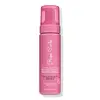What's inside
What's inside
 Benefits
Benefits

 Concerns
Concerns

 Ingredients Side-by-side
Ingredients Side-by-side

Aloe Barbadensis Leaf Juice
Skin ConditioningWater
Skin ConditioningDecyl Glucoside
CleansingVp/Va Copolymer
Phenoxyethanol
PreservativeCocos Nucifera Water
MaskingCocos Nucifera Fruit Extract
EmollientPsidium Guajava Fruit Extract
AstringentMangifera Indica Seed Butter
Skin ConditioningPolysorbate 20
EmulsifyingSodium Lauroyl Lactylate
EmulsifyingPolyquaternium-69
Alcohol Denat.
AntimicrobialGlycerin
HumectantDisodium EDTA
Parfum
MaskingAloe Barbadensis Leaf Juice, Water, Decyl Glucoside, Vp/Va Copolymer, Phenoxyethanol, Cocos Nucifera Water, Cocos Nucifera Fruit Extract, Psidium Guajava Fruit Extract, Mangifera Indica Seed Butter, Polysorbate 20, Sodium Lauroyl Lactylate, Polyquaternium-69, Alcohol Denat., Glycerin, Disodium EDTA, Parfum
Water
Skin ConditioningGlycerin
HumectantCocamidopropyl Betaine
CleansingPolysorbate 20
EmulsifyingDecyl Glucoside
CleansingCocos Nucifera Water
MaskingFurcellaria Lumbricalis Extract
Skin ConditioningCereus Grandiflorus Flower Extract
Skin ConditioningPassiflora Incarnata Seed Oil
Skin ProtectingAloe Barbadensis Leaf Powder
Skin ConditioningPanthenol
Skin ConditioningSalvia Hispanica Seed Extract
EmollientLinum Usitatissimum Seed Extract
PerfumingPolyurethane-14
Sodium Laneth-40 Maleate/Styrene Sulfonate Copolymer
Amp-Acrylates Copolymer
Aminomethyl Propanol
BufferingLeuconostoc/Radish Root Ferment Filtrate
AntimicrobialSodium Chloride
MaskingTetrasodium Glutamate Diacetate
Citric Acid
BufferingCaprylic Acid
CleansingBenzyl Alcohol
PerfumingXylitol
HumectantSorbic Acid
PreservativeParfum
MaskingPotassium Sorbate
PreservativeEthylhexylglycerin
Skin ConditioningPhenoxyethanol
PreservativeBenzyl Benzoate
AntimicrobialCitral
PerfumingCoumarin
PerfumingLimonene
PerfumingLinalool
PerfumingGeraniol
PerfumingWater, Glycerin, Cocamidopropyl Betaine, Polysorbate 20, Decyl Glucoside, Cocos Nucifera Water, Furcellaria Lumbricalis Extract, Cereus Grandiflorus Flower Extract, Passiflora Incarnata Seed Oil, Aloe Barbadensis Leaf Powder, Panthenol, Salvia Hispanica Seed Extract, Linum Usitatissimum Seed Extract, Polyurethane-14, Sodium Laneth-40 Maleate/Styrene Sulfonate Copolymer, Amp-Acrylates Copolymer, Aminomethyl Propanol, Leuconostoc/Radish Root Ferment Filtrate, Sodium Chloride, Tetrasodium Glutamate Diacetate, Citric Acid, Caprylic Acid, Benzyl Alcohol, Xylitol, Sorbic Acid, Parfum, Potassium Sorbate, Ethylhexylglycerin, Phenoxyethanol, Benzyl Benzoate, Citral, Coumarin, Limonene, Linalool, Geraniol
Ingredients Explained
These ingredients are found in both products.
Ingredients higher up in an ingredient list are typically present in a larger amount.
Decyl Glucoside is a glucose-based surfactant and emulsion stabilizer. It is created by reacting glucose with the fatty acids from plants.
Surfactants help clean the skin by trapping oil, sebum, and dirt to be washed away. As an emulsion stabilizer, it stabilizes the ingredients in a product by preventing them from separating.
This ingredient is biodegradable and non-toxic. This ingredient is commonly found in baby shampoos.
Decyl Glucoside is sometimes used to stabilize the UV filter Tinosorb.
Learn more about Decyl GlucosideGlycerin is already naturally found in your skin. It helps moisturize and protect your skin.
A study from 2016 found glycerin to be more effective as a humectant than AHAs and hyaluronic acid.
As a humectant, it helps the skin stay hydrated by pulling moisture to your skin. The low molecular weight of glycerin allows it to pull moisture into the deeper layers of your skin.
Hydrated skin improves your skin barrier; Your skin barrier helps protect against irritants and bacteria.
Glycerin has also been found to have antimicrobial and antiviral properties. Due to these properties, glycerin is often used in wound and burn treatments.
In cosmetics, glycerin is usually derived from plants such as soybean or palm. However, it can also be sourced from animals, such as tallow or animal fat.
This ingredient is organic, colorless, odorless, and non-toxic.
Glycerin is the name for this ingredient in American English. British English uses Glycerol/Glycerine.
Learn more about GlycerinParfum is a catch-all term for an ingredient or more that is used to give a scent to products.
Also called "fragrance", this ingredient can be a blend of hundreds of chemicals or plant oils. This means every product with "fragrance" or "parfum" in the ingredients list is a different mixture.
For instance, Habanolide is a proprietary trade name for a specific aroma chemical. When used as a fragrance ingredient in cosmetics, most aroma chemicals fall under the broad labeling category of “FRAGRANCE” or “PARFUM” according to EU and US regulations.
The term 'parfum' or 'fragrance' is not regulated in many countries. In many cases, it is up to the brand to define this term.
For instance, many brands choose to label themselves as "fragrance-free" because they are not using synthetic fragrances. However, their products may still contain ingredients such as essential oils that are considered a fragrance by INCI standards.
One example is Calendula flower extract. Calendula is an essential oil that still imparts a scent or 'fragrance'.
Depending on the blend, the ingredients in the mixture can cause allergies and sensitivities on the skin. Some ingredients that are known EU allergens include linalool and citronellol.
Parfum can also be used to mask or cover an unpleasant scent.
The bottom line is: not all fragrances/parfum/ingredients are created equally. If you are worried about fragrances, we recommend taking a closer look at an ingredient. And of course, we always recommend speaking with a professional.
Learn more about ParfumPhenoxyethanol is a preservative that has germicide, antimicrobial, and aromatic properties. Studies show that phenoxyethanol can prevent microbial growth. By itself, it has a scent that is similar to that of a rose.
It's often used in formulations along with Caprylyl Glycol to preserve the shelf life of products.
Polysorbate 20 is made by combining ethoxylation of sorbitan, ethylene oxide, and lauric acid. It is a mild cleansing agent, surfactant, and emulsifier.
As a surfactant, it helps collect dirt and oils for washing. Emulsifiers prevent oils and water from separating.
Polysorbate 20 also adds scent to a product. Since it is made using sorbitol, it has a sweet scent. Sorbitol can also be found in fruits such as apples and peaches.
The lauric acid used to create Polysorbate 20 is often derived from coconuts.
Polysorbate 20 may not be fungal acne safe.
Learn more about Polysorbate 20Water. It's the most common cosmetic ingredient of all. You'll usually see it at the top of ingredient lists, meaning that it makes up the largest part of the product.
So why is it so popular? Water most often acts as a solvent - this means that it helps dissolve other ingredients into the formulation.
You'll also recognize water as that liquid we all need to stay alive. If you see this, drink a glass of water. Stay hydrated!
Learn more about Water